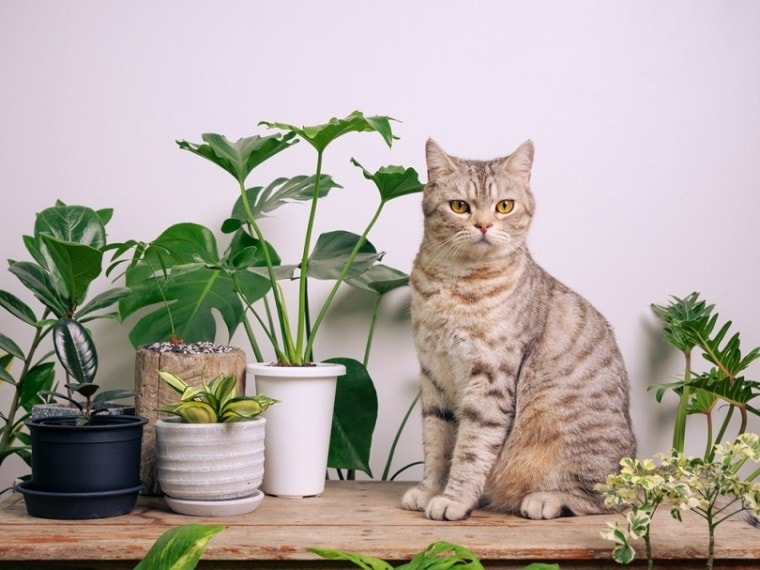
Plants liven up rooms, freshen our air, and bring color to our interior spaces. If you live with a cat, you may be concerned about having potentially toxic plants around your pet. Below you’ll find a list of some of the top plants that are safe for cats.
They’re non-toxic, so if your pet takes a few bites, there’s probably not much to worry about. But keep in mind that even non-toxic plants can upset feline tummies, and cats can end up with dangerous gastrointestinal tract obstructions if they eat string holding up plants and mouth injuries from biting on sharp twigs. Contact your veterinarian for guidance if your pet eats toxic or non-toxic plants and becomes ill.
Top 24 Plants That Are Safe for Cats
1. Ponytail Palm
Scientific Name: Beaucarnea recurvata
Native to southwestern Mexico, Guatemala, and Belize, ponytail palms can reach heights up to 8 feet tall when properly cared for. The plants grow nicely outdoors in temperate areas but usually must be brought inside during winter. They’re evergreen shrubs, not palms, with long frond-like leaves that fall gracefully downward from a central crown. Although ponytail palms can produce flowers, houseplants rarely do. They’re also known as bottle palms and elephant-foot trees.
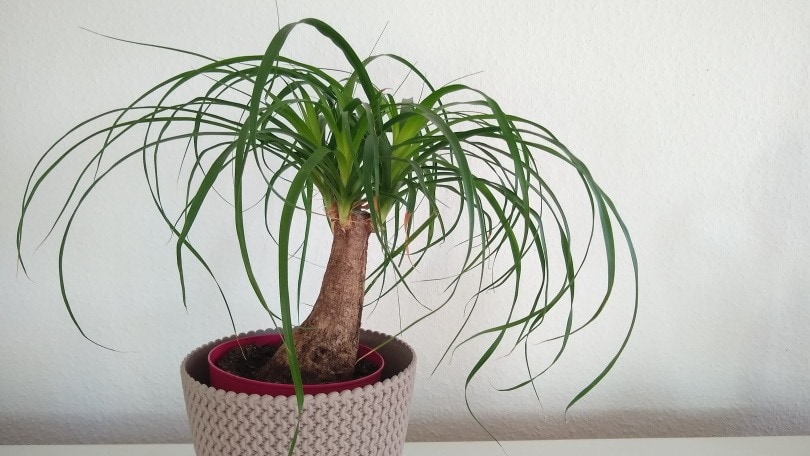
2. American Rubber Plant
Scientific Name: Peperomia obtusifolia
American rubber plants are low-maintenance houseplants featuring gorgeous deep green waxy leaves. However, some have leaves with a green and white marble pattern. They have stiff stems and can grow to be around 1 foot tall. They’re native to areas in Mexico, the Caribbean, and South America. They’re related to the plants that produce black pepper. They thrive in indirect light and only need moderate watering. American rubber plants are also known as baby rubber plants and pepper face plants.
3. Spider Plant
Scientific Name: Chlorophytum comosum
Spider plants have long medium-green leaves. Some types have green leaves with light centers. They’re native to regions in southern Africa and can reach heights of up to 2 feet. Indoor plants do best in bright but indirect sunlight and prefer soil with good drainage. Outdoors they’re often used as edging and groundcover. Spider plants produce small white flowers. They’re also called Anthericum, ribbon plants, and spider ivy.

4. Cast Iron Plant
Scientific Name: Aspidistra elatior
Cast iron plants are fantastic options for those still working on developing their green thumbs — they’re stunningly resilient. They grow well in various temperatures, don’t require much humidity, and aren’t particularly difficult when it comes to watering. They can grow to be around 3 feet tall. Cast iron plants prefer indirect sunlight but are generally fine in the shade. Other names for cast iron plants include iron plants, bar room plants, and variegated cast iron plants.
5. Christmas Cactus
Scientific Name: Schlumbergera bridgesii
Christmas cacti often appear in stores during the winter, when the plants sport bright red flowers. They’re technically flowering perennial cacti. They typically bloom during the winter. They often don’t react well to sudden temperature changes and can have difficulty adjusting to moving to new locations. Temperature and light must be strictly controlled during the fall for these plants to produce their famous flowers. Easter cactus is another name for the plant.

6. African Violet
Scientific Name: Saintpaulia spp.
Several plants fall in the Saintpaulia genus, and African violets come in several leaf shapes and colors. There are even miniature versions of these popular plants. They’re native to parts of eastern Africa and have become incredibly popular houseplants thanks to their year-round blooms. But they can be a bit particular regarding light and moisture. They’re also called Cape Marigolds.
7. Phalaenopsis Orchid
Scientific Name: Phalaenopsis sp.
Phalaenopsis orchids are incredibly popular among indoor gardeners. They’re one of the most beginner-friendly orchids commonly available and are relatively inexpensive. They produce colorful flowers in various colors, including pink, yellow, and white. Phalaenopsis are tropical epiphytic orchids that grow on tree trunks and branches without harming their hosts. They’re native to southeast Asia and prefer warm temperatures and humid conditions. The plants are also known as moon orchids and moth orchids.
8. Boston Fern
Scientific Name: Nephrolepis exalta bostoniensis
Boston ferns appear delicate but are incredibly tough. They make wonderful houseplants and are relatively easy to keep happy. They’re native to tropical locations in Africa and South America. Their drooping leaves look fantastic hanging from baskets or pedestals. Indoor plants often grow to about 3 feet tall. Boston ferns in the wild can grow to a stunning 7 feet! They love humidity, so most do well in bathrooms and kitchens. They’re sometimes called sword ferns.
9. Burro’s Tail
Scientific Name: Sedum morganianum
Burro’s tail is a succulent plant with long trailing stems and beautiful dark green, thick waxy leaves. They’re often displayed in hanging planters to show off their gorgeous trails. They’re native to parts of Mexico and the Caribbean. They can be grown indoors as a houseplant, but they can also thrive outdoors in areas where the temperature generally stays above 40ºF. Other names for the plant include donkey’s tail, horse’s tail, and lamb’s tail.
10. Gerbera Daisy
Scientific Name: Gerbera jamesonii
Gerbera daisies are herbaceous perennials native to southern Africa. They produce stunning flowers with red or yellow petals surrounding a vibrant orange-hued disk. Varieties that make white and pastel-colored flowers are also available. Gerbera daisies are often planted outside during the spring and summer. They typically enjoy areas with warm days and relatively cool nights. Gerbera daisies are also known as African, Barberton, Transvaal, and veldt daisies.
11. Blue Echeveria
Scientific Name: Echeveria glauca
Blue echeveria plants are commonly found in rock gardens and decorative terrariums. Their fleshy leaves grow upright in circular patterns. They are sensitive to cold temperatures and often do best as indoor ornamental plants. They thrive when exposed to direct sunlight, such as on windowsills. Indoor plants require regular turning to ensure even growth. The plant is also commonly called a wax rosette, maroon chenille plant, copper rose, painted lady, and plush plant.
12. Parlor Palm
Scientific Name: Chamaedorea elegans
Parlor palms are trunked palms that often do pretty well as houseplants. They’re native to parts of Guatemala and Mexico but are now commonly found in homes and offices worldwide. Parlor palms can reach heights up to 6 feet tall in ideal outdoor conditions. Most indoor plants top out around 4 feet or so. Other names for the plant include dwarf palm, bamboo palm, miniature fishtail palm, and good luck palm.

13. Aluminum Plant
Scientific Name: Pilea cadieri
Aluminum plants have sturdy dark green oval leaves featuring silvery highlights. The plants are originally from southeast Asia. Aluminum plants are ideal for inexperienced indoor gardeners since they require minimal maintenance. They usually do best in humid environments and strongly prefer indirect sunlight. Outdoor plants produce small flowers, but indoor plants typically don’t. New plants are relatively easy to grow from stem cuttings. They’re also called watermelon plants.
14. Artillery Plant
Scientific Name: Pilea microphylla
Artillery plants are herbaceous perennials often displayed as houseplants. They’re native to parts of Central America, Mexico, and South America and typically prefer temperate humid environments. Artillery Plants can grow to around 1 foot tall indoors. Outdoors, they tend to spread, creating ground cover. They have a shrub-like appearance and feature small green oval leaves. Outdoor plants produce small reddish-pink flowers. Artillery plants are often mistaken for ferns due to their delicate leaves.
15. Swedish Ivy
Scientific Name: Plectranthus australis
Swedish ivy is a lush herbaceous evergreen perennial with long trailing stems and broad, delicate light green leaves. The plants grow well outdoors when given steady moisture and just the right amount of shade. Too much sun can prevent them from growing, and outdoor plants need to be taken inside when the temperatures drop. Purple and white flowers adorn the Swedish ivy when in bloom, and the plant is also called creeping Charlie.
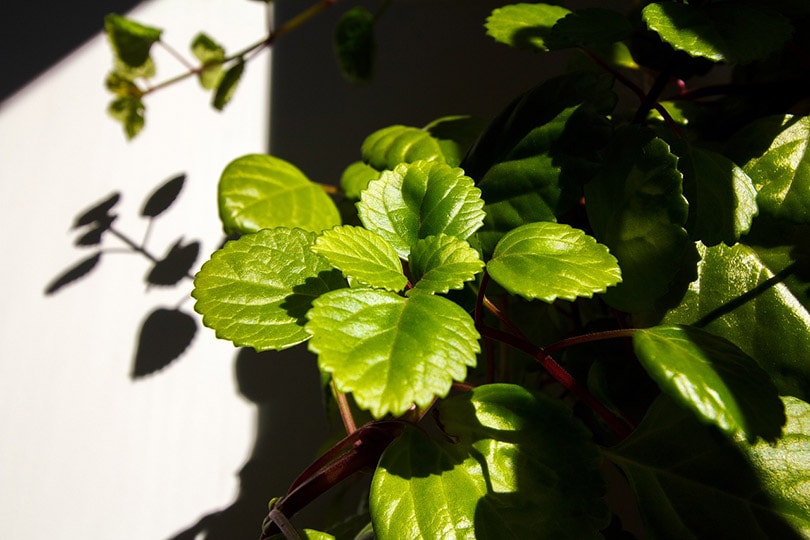
16. Gloxinia
Scientific Name: Sinningia speciosa
Gloxinia is a gorgeous flowering plant often grown from bulbs. They feature stunning 4-inch bell-shaped flowers in red, purple, lavender, and white colors. The plant is native to parts of Brazil and is closely related to African violets. They thrive indoors with limited but regular watering and exposure to indirect sunlight. Most bloom for a few months during the spring and summer. Avoid getting the plant’s leaves wet if possible—it often leads to the development of brown spots.
17. Areca Palm
Scientific Name: Dypsis lutescens
Areca palms have stiff, yellowish stems that branch upward from a central point. Long delicate leaves dangle from the plant’s stems, appearing thick and fibrous at the base. They’re native to Madagascar, where they can reach heights of 30 feet. Outdoors, they thrive in warm, shady, humid environments. Areca palms produce yellow flowers between July and August. They’re also known as cane palms, golden butterfly palms, yellow palms, and golden feather palms.

18. Baby’s Tears
Scientific Name: Soleirolia soleirolii
Baby’s tears are a member of the nettle family, and they’re technically creeping perennials. They’re native to various parts of the Mediterranean region, including the islands of Sicily and Corsica. The plants don’t grow very tall, but they can easily cover around 6 feet of ground under the right outdoor conditions. They grow well indoors, as they don’t require much light. The plant is also called Irish moss, peace-in-the-home, Corsican carpet, Pollyanna vine, Japanese moss, angel’s tears, and mind-your-own-business.
19. Hibiscus
Scientific Name: Hibiscus syriacus
Hibiscus plants are flowering shrubs. They produce stunning pink flowers with red middles between June and October. The sweet, smelling flowers are famous for attracting birds and butterflies. Outdoor plants should be brought inside when the temperature drops. Other names for the plant include rose of China, shrub althea, and rose of Sharon.
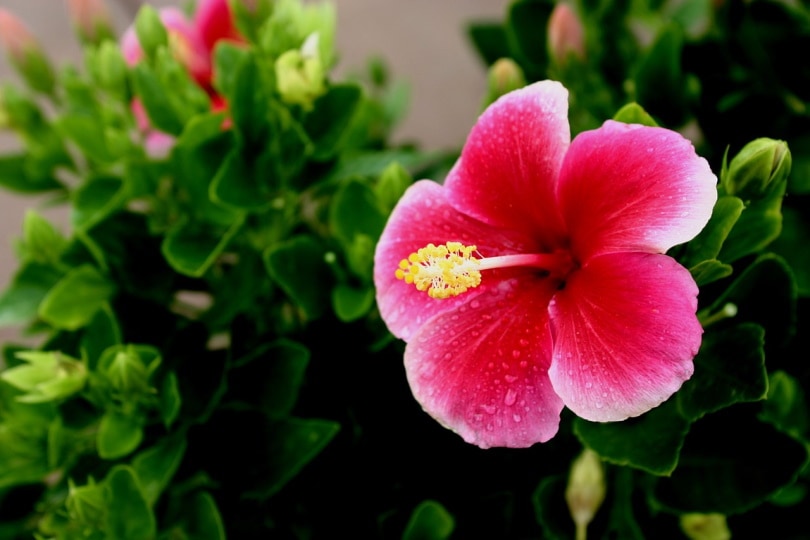
20. Majesty Palm
Scientific Name: Ravenea rivularis
Majesty palms are evergreen perennials native to Madagascar. They’re now most often grown as indoor plants. They produce flexible long green fronds and can become quite massive outdoors. Inside, they can easily reach up to 10 feet tall. They’re often considered challenging to care for and require the right combination of light and fertilizer to prevent scorching. They’re also called majestic palms.
21. Friendship Plant
Scientific Name: Pilea involucrata
Friendship plants produce oval green leaves with silver and bronze highlights set off by deep red veins. They’re creeping perennials native to parts of Central and South America. Friendship plants are generally considered easy-to-care-for, low-maintenance choices. However, they prefer high humidity and relatively warm conditions. Some produce tiny pink flowers in the spring. They’re pretty easy to propagate from stem cuttings.
22. Copper Rose
Scientific Name: Echeveria multicaulis
Copper Roses are perennial herbaceous succulents native to parts of Mexico. They produce thick, fleshy green leaves with red tips in tight rosettes. Red and yellow flowers bloom during the spring and summer. They’re drought-tolerant and do well in rock gardens and terrariums. Most stay close to the ground, but the plants can grow 6 feet wide. Other names for the plant include painted lady and copper leaf.
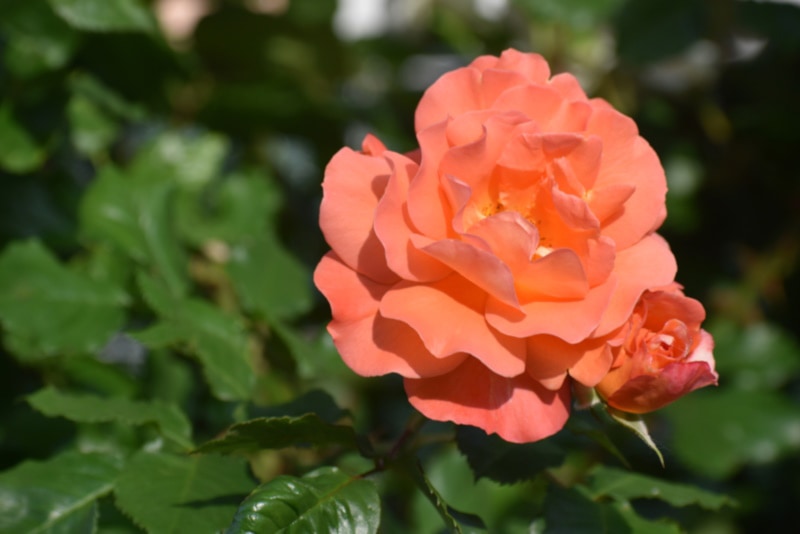
23. Metallic peperomia
Scientific Name: Peperomia caperata
Metallic peperomia plants have deep, dark green wrinkled leaves. They’re herbaceous evergreens that stick close to the ground and seldom grow taller than about 8 inches. They’re typically easy to keep healthy as long as they’re not overwatered. Metallic peperomia are native to South America. The plant is also referred to as emerald ripple peperomia, emerald ripple pepper, ivy-leaf peperomia, ripple peperomia, green ripple peperomia, little fantasy peperomia, and silver heart.
24. Star Jasmine
Scientific Name: Trachelospermum jasminoides
Star jasmine plants are stunning evergreen perennials that produce gorgeous white flowers in the spring. The flowers are quite popular among bees! They’re most often seen outdoors as shrubs or vines, but they’re also popular houseplants due to their beautiful blooms. When grown as vines, they require sturdy climbing structures. Star jasmine flowers in all sorts of light conditions, from shade to full sun.

Conclusion
While all of the plants on this list aren’t toxic to cats, you should still take steps to keep your buddy from nibbling on them at leisure. Cats with sensitive stomachs can often develop gastrointestinal problems such as vomiting and diarrhea after eating non-toxic plants that don’t agree with them. Keep your houseplants out of your pet’s reach if possible, and contact your veterinarian if your cat gets sick after eating a plant. Take a picture of what your cat ate to show your veterinarian, as it can sometimes be difficult to identify unfamiliar plants.
Related reads:
- How to Keep Cats Off Outdoor Furniture (14 Proven Methods)
- Are Peace Lilies Toxic to Cats? Facts, Signs & Prevention
- How To Grow Water Trumpets: Planting and Care Guide
Featured Image Credit: Foto2rich, Shutterstock








